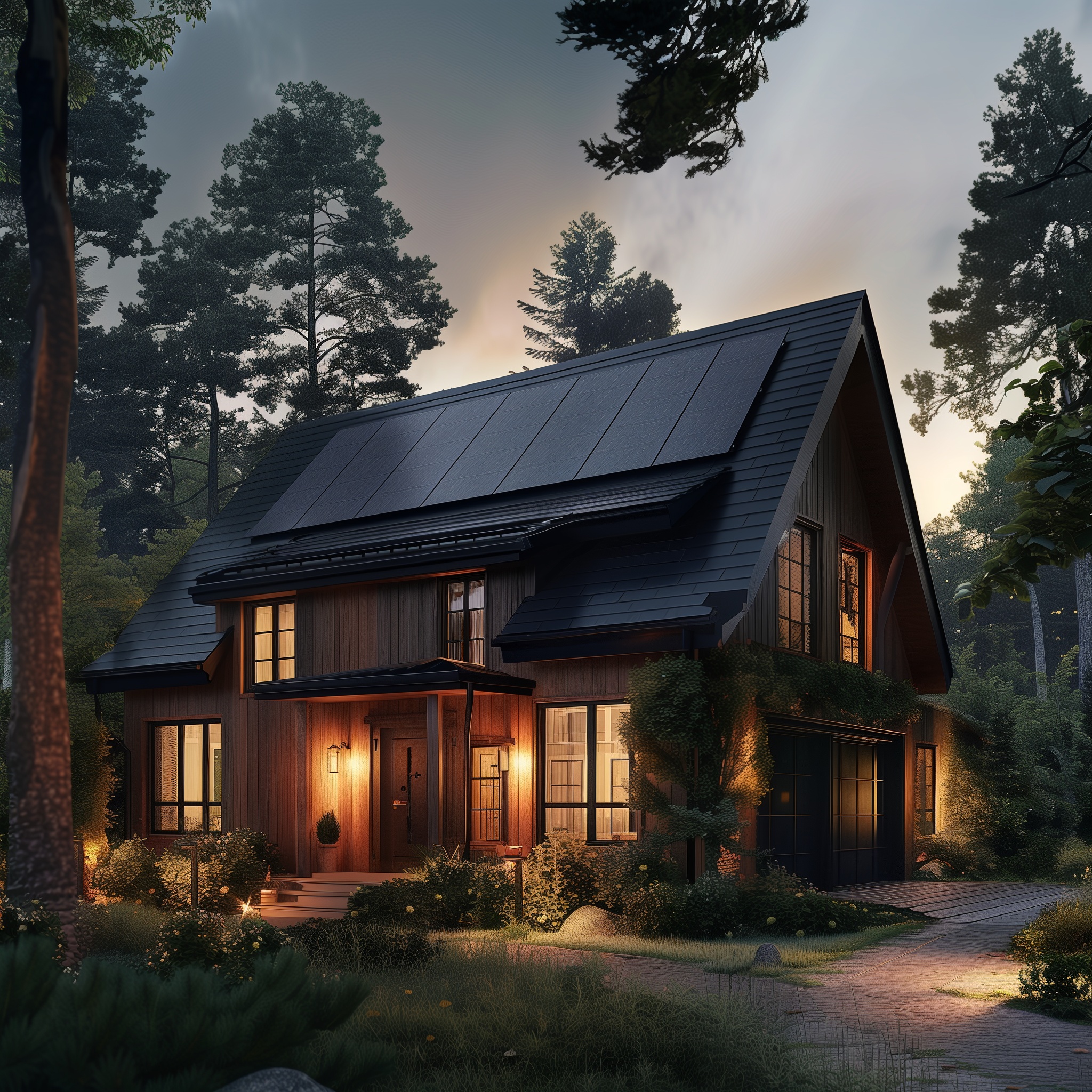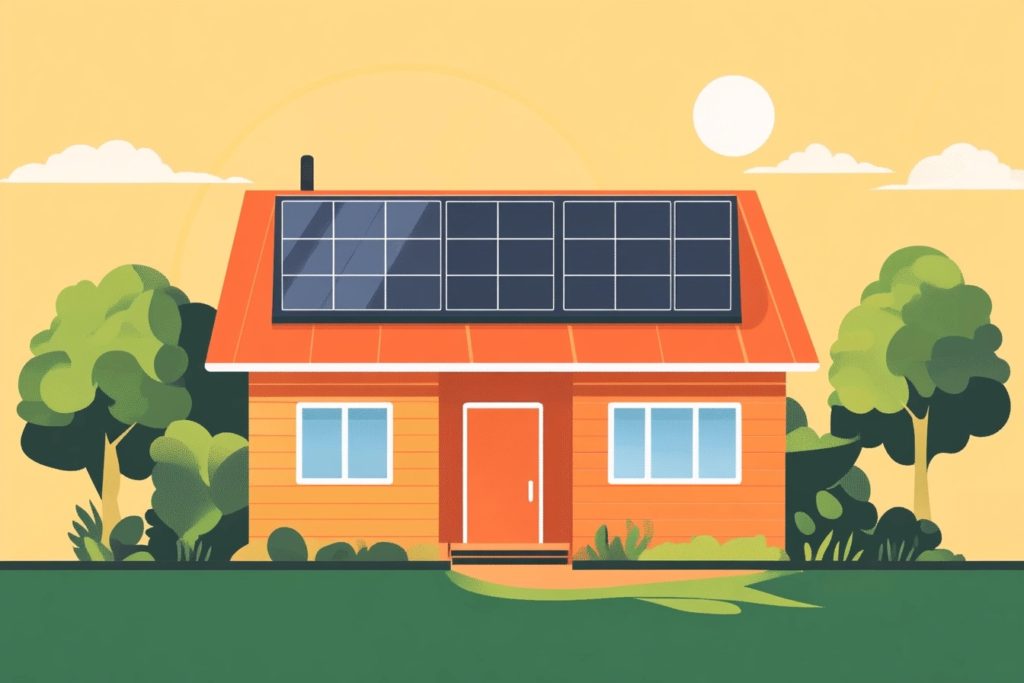
There’s no doubt that solar is making its way onto the roofs of homes across the country. People who make the switch to alternative energy not only help sustain the environment but find incredible returns on their investments. But the technology is advanced, and you might want to know a little more about how it works before you commit.
You might be asking yourself “how much does one solar panel produce?” An important question to understand how many panels you’d need to power your home. For the answer to this and more, continue reading.
How Do Solar Panels Work?
With increasing political and social demands for cleaner energy, solar panels have become a hot commodity. To understand the amount of power they produce, it’s helpful to know how they work.
Solar panels are made of a series of solar cells, which convert thermal energy into electricity. These cells are made of semiconductor material (materials that are only partially conductive) to absorb sunlight. The semiconductor materials allow the electrons from light to travel in a current to the electrical grid.
There are several types of semiconductor materials used that give solar cells different properties. Some of the features that help determine what semiconductor is used include:
- Bandgap (the sunlight wave frequency that the cell can absorb)
- Lifespan
- Cost
- Accessibility
The most common semiconductor used in residential solar panel systems is silicon. This material is highly accessible and offers an efficient bandgap. While other photovoltaic (PV) methods allow for more efficiency, their cost makes them less suitable for residential purposes (NASA uses panels with 45% power output ratings!).
How to Calculate Solar Panel Output
As children, we were probably taught to stay away from electrical wires. The consequences of doing that are so powerful, that it might even make us cautious just thinking about them. But calculating the amount of electricity generated from solar panels is pretty straightforward.
To get started, let’s figure out how many watt-hours our panel produces. For that, we need a couple of numbers:
- The wattage of the panel (watts per hour it can produce)
- The peak sun hours in the area (here’s an easy chart breaking it down by state)
To find out how many watt-hours our panel produces per day, all we have to do is multiply the wattage by the number of peak sun hours. We’ll use an example to demonstrate. Let’s say our solar panel produces 300 watts and we’re located in Utah, which has 5.26 peak sun hours:
300 watts x 5.26 peak sun hours= 1,578 watt-hours per day
Now typically for homeowners, watt-hours are read as kilowatt-hours. So for the example above, all we need to do is divide 1,578 by 1,000. This panel can produce 1.6kWh per day.
As it relates to residential purposes, we might also want to know how to figure the amount of solar power produced per month. That’s as simple as taking our daily kWh (in this example, 1.6kWh) and multiplying it by 30:
1.6kWh x 30 days = 48 kWh per month
When wondering “how much does one solar panel produce,” this equation can help us calculate its standard output. Keep in mind that the amount of wattage can differ per panel, and there are several conditions that can affect the actual solar power output rating.
How Much Does One Solar Panel Produce?
To help us calculate our watt-hours, we need to know how much wattage one solar panel can produce in an hour. Depending on the semiconductor and the number of solar cells in the panel, the wattage can differ.
Most residential solar panels on the market have between 36 and 144 cells, which range from 100w to 400w. The most common solar panels have 60 to 72 cells for about 250w to 300w.
The PV tactics (or semiconductors used) can also affect the amount of power produced. The two main types of solar panel PV include:
- Monocrystalline, which is made of a single silicon crystal
- Polycrystalline, which uses a blend of several silicon crystals
Monocrystalline panels are often more efficient than polycrystalline. We can expect monocrystalline panels to produce 2-7% more energy, which adds up the more cells a solar panel has.
Conditions That Affect the Amount of Energy Produced
We would love for our solar panels to produce their max capability as determined under standard test conditions. Inevitably, however, there are conditions that make them less efficient.
In fact, most panels only reach 20% efficiency. When determining how much power your panel can produce, consider these factors:
Solar Panel Position
The orientation of the solar panel in relation to the sun makes a huge difference in the amount of energy captured. If sunlight can’t directly reach the solar cells, they can’t absorb it well.
When positioning a solar panel, think about where the sun is located. Every state is north of the equator, meaning the sun will always be on the south side of homes. However, homes in Florida or Hawaii will have the sun overhead more often than homes in Alaska, so consider the angle at which the panel is positioned.
Location
We touched on this a bit earlier, but the location is important in determining the number of peak sunlight hours a panel is exposed. Geographic features such as mountains and lakes, as well as latitudinal (the lines that go horizontal) location can affect the amount of sunlight a place receives.
Here’s an example of how much this matters. Panels in Illinois (with 3.1 peak sun hours) will need over twice as much wattage as panels in Nevada (with 6.4 peak sun hours) to produce the same amount of solar power.
Shade
Shade can affect the output of a panel way more than expected. If even one solar cell is covered, it can drastically reduce the output of the entire panel.
This happens because every cell of the panel is connected to the same current. Essentially, the shaded cell acts as a clog in the current; unshaded cells can only push an amount of energy that will fit through the clog. This results in a panel that can only produce as much power as its weakest solar cell.
Temperature
Believe it or not, solar panels actually lose efficiency in extreme heat. When considering adding a solar array, keep in mind that hot, summer days can drop solar production by as much as 10%.
To accommodate for hot areas, a couple of methods help keep temperatures cool. Proper solar installation allows a few inches of roof space for airflow. Additionally, different colored panels other than black will result in less heat absorption.
How Big of a Solar Panel System to Power My House?
Many homeowners look to solar as an alternative energy source. Several panels are strung together to create a solar array which varies in size depending on the amount of power needed. We can determine our energy needs based on our location and monthly power usage.
So if we’re located in Utah (as in our first example) and we use 760kWh per month, we would want 4.8kW of solar to completely cover our usage. That’s a solar array of 16 panels producing 300w each.
Of course, as briefly mentioned earlier, some places might need significantly more wattage to cover their needs. On average, residential solar arrays use 6kW of solar to cover their electrical usage.
How a Residential Solar Panel System Can Save Me Money
Many people are adopting solar systems for their power supply, not only because it’s environmentally friendly but also because it’s saving them money on their utility bills. In fact, solar arrays can save homeowners nearly 100% on electricity.
For those that opt into power storage, their savings can even turn into earnings. Residents in some cities can connect their solar system to the area’s power grid and utility companies will pay for excess power.
The biggest concern people have with switching to solar is the cost of installation. But with the rapidly growing market, even that is becoming affordable. With federal backing and state incentives, people can cut the cost of installation by over 25% or more.
Where many people find significant value is in their long-term investment. While they’re paying upfront installation costs, the system can go with little maintenance for up to 25 years. Over the life of their system, most people will find substantial savings.
How Much Can You Expect to Pay For Solar?
Now that we understand the question of how much does one solar panel produce, we can start to determine how big of a solar array we need to power our home. Regardless of the size, however, there are incredible savings to be earned.
For help estimating how much a solar array might cost us, we recommend our personalized solar estimate. As one of the top-rated solar companies, we’re committed to connecting you to the best solar options in the country.




